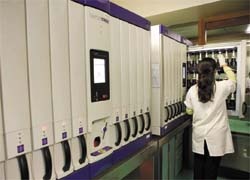Laboratory Outsourcing: What next?
By Mary Black
A quiet revolution is occurring in clinical laboratory services. In any business model, laboratory services are cost centres, and cost centres can be moved around, services outsourced, amalgamated, contracted out. Globally, diagnostics and laboratory outsourcing are following the already trodden path of information technology.

Two types of work are involved in the move overseas – diagnostics and pathology testing, and clinical trials/
research.
There are three ways of handling the sample materials themselves:
l Clinical materials can be sent overseas for direct testing
l Photomicrographs of lab tests can be sent for review and reporting by experts. Time zone differences can be used to advantage, with reports sent overnight to be picked up on the next business day.
l Testing on humans can be sent overseas (as in clinical trials) and laboratory services simply follow.
This really is big business. 20 years ago, in the USA diagnostics was a highly fragmented industry. It is now annually a $50 billion industry, with 50% coming from the top five chains. This pattern is replicating across the world and chains of consolidated super labs, providing services on a contracted basis, are becoming well established in Europe. The next business trend
will be transnational outsourcing. National health services and individual hospitals are dipping their toes in the market, attracted by costs that may be considerably lower than a local laboratory. The use of telepathology services are increasing in Europe and the US, but also in countries such as West Asia, Sri Lanka, Africa, Nepal and Bangladesh. Metropolis, a market leader in diagnostic services nationally in India, also provides hospital laboratory management services with labs in the Middle East and South-East Asian countries, including Thailand, Indonesia and Vietnam. They process more than 10 million sample tests in their global chain annually, but only 1.0% is classed as outsourcing. This is set to rise.
Clinical Research outsourcing has moved faster, driven by lower costs and access to clinical subjects.
An estimated 30 Global Clinical Research Outsourcing (CRO) companies are involved in India alone. Dr Umakanta Sahoo, a managing director of the global CRO firm Chiltern international, expects the Indian market to hit the $1-1.5 billion mark by 2010. Most of their work comes from Europe (70–80%) and the remainder from the US (almost 20%).
New concerns are arising out of this outsourcing shift, including how to deal with patient confidentiality, regulatory barriers, and an ongoing debate on quality and the minimisation of reporting errors. These have been ongoing concerns for laboratory services for years; the difference now is that debate crosses not just organisational but international boundaries. We can predict that lower prices alone will not drive the industry, but that quality will come to the fore. Public awareness of laboratory outsourcing is still low, but as the industry develops, patient and other advocacy groups will enter the debate.
01.09.2008











